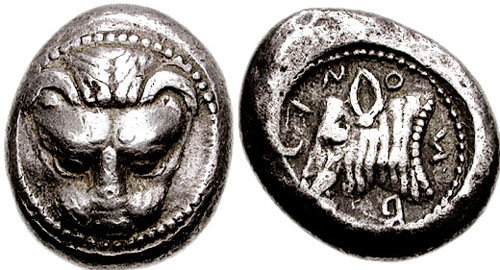
Zankle in Sicily invited a group of Samian refugees to settle nearby after Samos fell to the Persians. The Samians chose instead to seize the undefended city itself, at the behest of the tyrant Anaxilas of Rhegion. Upon doing so, the Samians in turn betrayed Anaxilas, and allied themselves with Hippocrates of Gela. Around 488 BC, Anaxilas suppressed the Samians, seized Zankle, and resettled it with colonists from Peloponnesian Messenia. In honor of their loyalty, Anaxilas renamed the city Messana, after their homeland. On the occasion of Anaxilas' dominance of the Straits of Messana a joint coinage was struck for Messana and Rhegion, the initial coinage in the name of Messana and the first coinage for Rhegion excepting an extremely rare incuse issue about thirty years previous. The first coinage was established on the standard of the Chalkidian tridrachm or stater rather that the Attic tetradrachm, and was in circulation for only a few years until 480 BC, when Messana introduced the Olympic mule cart type tetradrachm. After the death of Anxailas in 476 BC the coinages of the two cities diverged and Messana fell more and more under the hegemony of Syracuse. This Rhegion stater is the heaviest of the sixteen specimens catalogued by Caltabiano.
BRUTTIUM, Rhegion. Circa 485/3-481 BC. AR Stater (17.83 gm, 2h). Euboic-Chalkidian standard. Facing lion's head / Head of calf left in dotted incuse circle. Caltabiano Series IB, 60,1 (pl. 61- D27/R27) = Attianese,
Calabria Graecia (1980), 1306 (this coin); SNG ANS 620; HN Italy 2469.